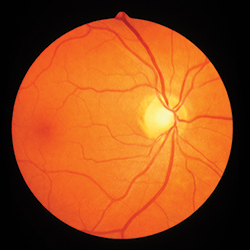JLR: Sphingolipids and retinal degeneration
Two uses for the same drug. It’s been done before with success. Take aspirin, which alleviates pain and is a blood thinner. Or Wellbutrin, which helps smokers quit and is an antidepressant. In a recently published paper in the Journal of Lipid Research, researchers took a multiple sclerosis drug called Gilenya from Novartis and gave it a new use: treatment of retinal degeneration.
 Gilenya, a multiple sclerosis drug, may have a new use as a treatment for retinal degeneration.
Gilenya, a multiple sclerosis drug, may have a new use as a treatment for retinal degeneration.
Why Gilenya? Gilenya, which also goes by the name FTY720, initially was used in multiple sclerosis, a central nervous system disorder involving the destruction of certain nerve cells. Gilenya is an altered version of a natural product and has immunosuppressive effects, particularly through the blockade of sphingolipid synthesis. This last point is key, as retinal degeneration also is known to involve sphingolipid biosynthesis.
Retinal degeneration is a catchall term for a group of diseases whose hallmark is photoreceptor cell death. This cell death has many contributing factors, one of which is ceramide, a sphingolipid whose role in retinal degeneration has been investigated by the group of Nawajes Mandal at the University of Oklahoma Health Sciences Center. In fact, in previously published work, the Mandal group identified ceramide as a critical player in retinal degeneration by using Gilenya in a rat model of light-induced retinal degeneration.
In the current JLR study, Mandal and colleagues turned their focus to a laboratory rat model, one which more frequently is used in the retinal degeneration field. This rat model closely matches how retinal degeneration happens in humans. Using this popular model gives a better idea of the effects of the drug. These transgenic animals start losing their sight at post-natal day 22 and have 50 percent photoreceptor death at postnatal day 45. This occurs because they have a mutated rhodopsin gene.
The investigators administered Gilenya to these rats at both the early and late stages of the disease and examined eye health, gene expression and sphingolipid levels. With early dosing of Gilenya came improved rod and cone function as well as lowered ceramide biosynthesis gene expression, two positive signs of improvement. In addition, the investigators noticed that the sphingolipid profile, a feature that was altered in the disease model, was reset, and they observed normal levels of associated enzymes were observed with Gilenya administration.
While Gilenya may appear to be a winner for retinal degeneration treatment, many questions remain. First, the exact pathway between ceramide biosynthesis and photoreceptor cell death needs to be established. Second, the precise mechanism of action of Gilenya also needs to be established. And, of course, many more studies with this drug in animal models have to be completed.
Still, this study makes a significant contribution to the search for retinal- degeneration drugs. Treatments for this disease are few and far between, and beginning with a Food and Drug Administration-approved drug is a good start to alleviating this disorder.
Enjoy reading ASBMB Today?
Become a member to receive the print edition four times a year and the digital edition monthly.
Learn moreGet the latest from ASBMB Today
Enter your email address, and we’ll send you a weekly email with recent articles, interviews and more.
Latest in Science
Science highlights or most popular articles

Bacteriophage protein could make queso fresco safer
Researchers characterized the structure and function of PlyP100, a bacteriophage protein that shows promise as a food-safe antimicrobial for preventing Listeria monocytogenes growth in fresh cheeses.

Building the blueprint to block HIV
Wesley Sundquist will present his work on the HIV capsid and revolutionary drug, Lenacapavir, at the ASBMB Annual Meeting, March 7–10, in Maryland.

Gut microbes hijack cancer pathway in high-fat diets
Researchers at the Feinstein Institutes for Medical Research found that a high-fat diet increases ammonia-producing bacteria in the gut microbiome of mice, which in turn disrupts TGF-β signaling and promotes colorectal cancer.

Mapping fentanyl’s cellular footprint
Using a new imaging method, researchers at State University of New York at Buffalo traced fentanyl’s effects inside brain immune cells, revealing how the drug alters lipid droplets, pointing to new paths for addiction diagnostics.

Designing life’s building blocks with AI
Tanja Kortemme, a professor at the University of California, San Francisco, will discuss her research using computational biology to engineer proteins at the 2026 ASBMB Annual Meeting.

Cholesterol as a novel biomarker for Fragile X syndrome
Researchers in Quebec identified lower levels of a brain cholesterol metabolite, 24-hydroxycholesterol, in patients with fragile X syndrome, a finding that could provide a simple blood-based biomarker for understanding and managing the condition.

